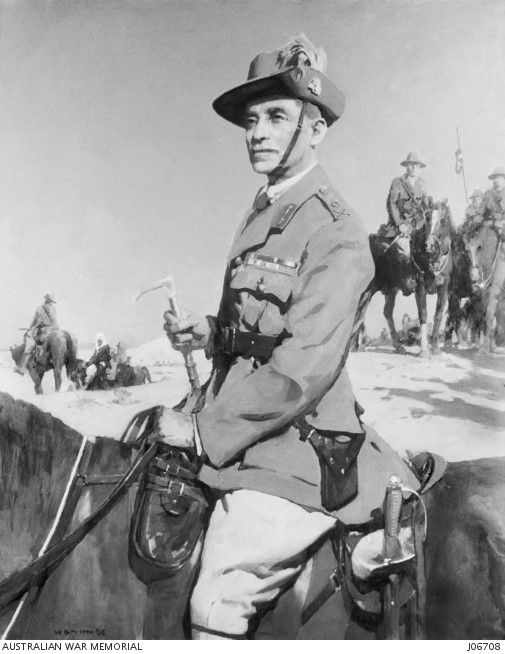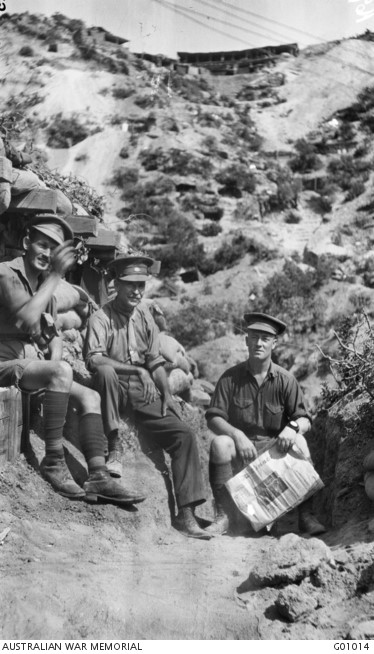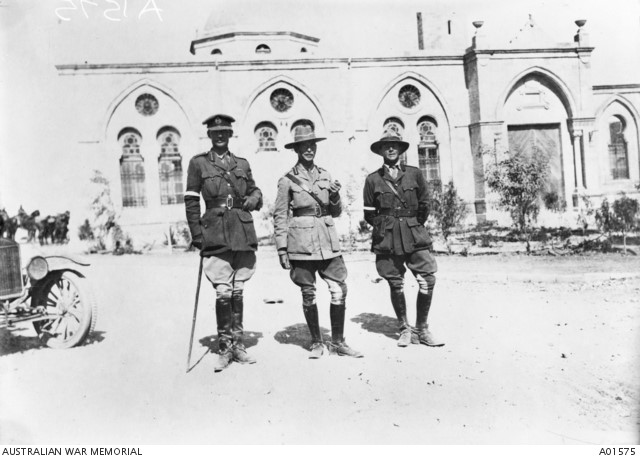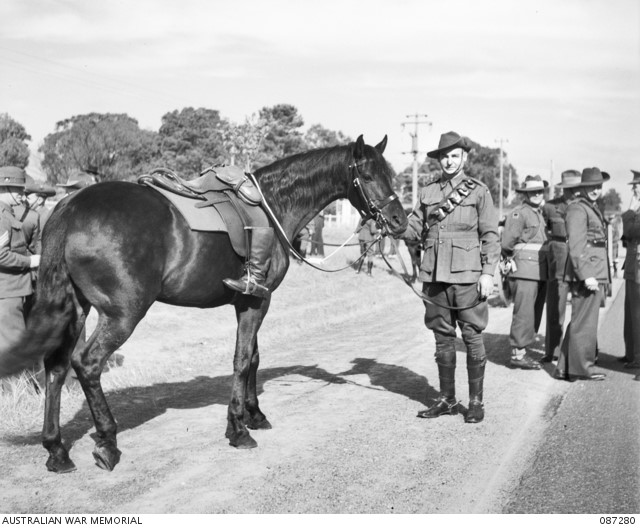General Sir Henry George (Harry) Chauvel GCMG, KCB, was one of Australia’s most distinguished and decorated army generals. He was the first Australian to rise to the rank of Lieutenant General and later General and the first one to command an entire Corps. By the end of World War 1, he led five brigades of Light Horse and cavalry to a successful sweep to break the Turkish cordon and defeat three Turkish armies to end the war in the Middle East.
 Harry Chauvel was born on April 16, 1865 in Tabulam, New South Wales and educated at Sydney Grammar and Toowoomba Grammar schools. His father had served in the British army and began his own unit, the Upper Clarence Light Horse, which Harry joined. He managed his father’s cattle properties and became an excellent horseman. In 1890 he was commissioned as a captain into the Queensland Mounted Infantry.
Harry Chauvel was born on April 16, 1865 in Tabulam, New South Wales and educated at Sydney Grammar and Toowoomba Grammar schools. His father had served in the British army and began his own unit, the Upper Clarence Light Horse, which Harry joined. He managed his father’s cattle properties and became an excellent horseman. In 1890 he was commissioned as a captain into the Queensland Mounted Infantry.
In the Boer War he commanded the A Squadron of the 1st Queensland Mounted Infantry. He was awarded a Companion of the Order of St Michael and St George (CMG). After the war he contributed to the training of the Light Horse in Australia, raising many of the future officers. In 1906 he married Sibyl and produced four children, with both sons serving in the army. By 1914 he had risen to be a colonel and appointed as the Australian representative on the Imperial General Staff in London. Before he arrived, war broke out and he was appointed to command the 1st Light Horse Brigade of the Australian Imperial Forces. He was largely responsible for ensuring they were off-loaded in Cairo instead of sailing on to Britain to spend winter in tents in England.
 His troops arrived in Gallipoli on May 12, 1915 and were posted to some of the most vulnerable places on the peninsula - Pope's Hill and Quinn's, Courtney's and Steele's Posts – relieving Monash’s troops. He managed to secure the mule track to make it safer to travel along Monash Valley. He contracted pleurisy and spent six weeks in hospital. On his return, he was promoted to Major General and commanded the evacuation and reorganisation of the troops in Egypt. He was known as a quiet, calm, caring, cooperative and courageous leader who stayed close to his men. He was made a Commander of the Order of the Bath (CB).
His troops arrived in Gallipoli on May 12, 1915 and were posted to some of the most vulnerable places on the peninsula - Pope's Hill and Quinn's, Courtney's and Steele's Posts – relieving Monash’s troops. He managed to secure the mule track to make it safer to travel along Monash Valley. He contracted pleurisy and spent six weeks in hospital. On his return, he was promoted to Major General and commanded the evacuation and reorganisation of the troops in Egypt. He was known as a quiet, calm, caring, cooperative and courageous leader who stayed close to his men. He was made a Commander of the Order of the Bath (CB).
When offered the choice of remaining with the Light Horse or taking a position in France, he chose the first. Now in command of the ANZAC Mounted Division, after the Turks raided the British outpost on April 23, 1916, he moved the troops over the Suez Canal. At Romani, he managed to lead his troops to a victory, and personally went to congratulate those involved after. He continued to push back the Turks through the Sinai and routed the outpost at Maghdaba. His strategy won the battle and he was appointed KCMG (Knight Commander of the Order of St Michael and St George). After the unsuccessful battles for Gaza, despite his troops having successfully entered the city and captured the wells, he was promoted to Lieutenant General and given command of the entire Desert Column, which was reorganised and renamed the Desert Mounted Corps, with 3 divisions. When they withdrew from Gaza, Chauvel ensured that even the Turkish wounded, who were unfit to march as prisoners, were left with a full bottle of water.
 Chauvel was said to be a man who knew the capabilities of his troops and would never opt for victory at all human cost. He valued the lives of his men and calculated the risk in his decision-making.
Chauvel was said to be a man who knew the capabilities of his troops and would never opt for victory at all human cost. He valued the lives of his men and calculated the risk in his decision-making.
At Beersheba in October 1917, it was the Australians under Chauvel’s orders that made the final charge to capture the city at sundown. He was awarded a KCB (Knight Commander of the Bath).
The following year, in the operations to capture Amman, though they failed militarily, they did succeed in leading the Turks to believe that the next attack would be from the East. His skillful handling of the withdrawal from Es-Salt, when the enemy was closing in quickly and the situation looked very grim, meant that many more casualties were averted.
Before the final assault of the Middle eastern Campaign, he successfully moved his troops from the Jordan to the orange groves near the Mediterranean coast without detection. By this time, he commanded the Australian, New Zealand, British, French and Indian troops. This is thought to be the largest number of mounted troops ever under one command. The Megiddo sweep, or ‘Great Ride’ broke through the Turkish defences and the cavalry rode 167 km in three days, destroying most of the opposition in the Holy Land. Even those that escaped east of the Jordan were overtaken by the ANZAC troops. After capturing Damascus on October 1, they headed north to Aleppo, another 300 km away. During this grand finale to the campaign, they took over 70,000 prisoners, with the loss of about 600 of their own men. This was a credit to Chauvel’s organisational skills, coordination and excellent preparation of troops from a variety of armies across a broad geographic area and in a number of successive operations. He was awarded the GCMG (Knight of the Grand Cross of the Order of St Michael and St George), the French Croix de Guerre and the Egyptian Order of the Nile.
Chauvel returned to Australia in September 1919 and became the Inspector General, the army’s highest position. He was promoted to Lieutenant General, then General in 1929. He battled governmental financial restraints, but was insistent on maintaining high standards, even when training a volunteer army. In his wisdom, he sent officers to Britain to study which meant that when World War II began they were well prepared. He continued his practice of meeting the troops personally and observing their training.
He retired in 1930, but never stopped his community involvement. He campaigned for veterans causes, was on the committees for the Australian and Victorian War Memorials, the Red Cross and Young Men’s Christian Association. He was a man of integrity and faith and was made a lay canon of St Paul’s Cathedral in Melbourne, where a plaque honours his memory to this day. He led Anzac Day marches until 1938, when he refused in protest to the Returned Servicemen’s League changing the service from a Christian service to a secular one.
In 1940, the Volunteer Defence Corps was established and he became its Inspector General until his death. He died in Melbourne on March 4, 1945 and was given a State funeral at St Paul’s Cathedral. His sword is in Christ Church, Sth Yarra and his uniform is at the War Memorial in Canberra.
 At Chauvel’s funeral procession, this riderless horse followed the gun carriage to Springvale Crematorium. The riderless horse, with boots reversed in the stirrups, signifies a warrior has fallen in battle and will ride no more.
At Chauvel’s funeral procession, this riderless horse followed the gun carriage to Springvale Crematorium. The riderless horse, with boots reversed in the stirrups, signifies a warrior has fallen in battle and will ride no more.
References:
https://www.awm.gov.au/people/P10676556/
http://adb.anu.edu.au/biography/chauvel-sir-henry-george-harry-5569. Article by J.P. Quinn
http://www.diggerhistory.info/pages-heroes/chauvel.htm
https://en.wikipedia.org/wiki/Harry_Chauvel
Pictures:
- Australian War Memorial https://www.awm.gov.au/collection/J06708/ Sir Harry Chauvel. Portrait by McInnis.
- Australian War Memorial https://www.awm.gov.au/collection/G01014/ Photo by Charles Bean. Gallipoli Peninsula, Turkey. 1915. General Chauvel with Major E.M. Williams, Brigade Major of the 1st Australian Light Horse (left) and Staff Captain Walter Percy Farr (right).
- Australian War Memorial https://www.awm.gov.au/collection/A01575/ General Sir H G Chauvel GOC, Desert Mounted Corps (centre) with Brigadier General R G H Howard-Vyse CMG DSO, his Brigadier General, General Staff (BGGS) (left) and Captain W G Lyons MC (right), one of his Aide de Camps (ADC). Photo taken the day after the capture of Beersheba.
- Australian War Memorial https://www.awm.gov.au/collection/087280/ Photo John Lee.
Sir Harry Chauvel's horse with the rider's boots set in reverse.

